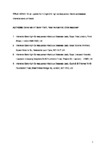COVID-19: An update from England’s high consequence infectious diseases intensive care unit leads
| dc.contributor.author | Martin, Daniel | |
| dc.contributor.author | Platt, S | |
| dc.contributor.author | Hampshire, P | |
| dc.contributor.author | Meadows, C | |
| dc.date.accessioned | 2020-07-09T13:20:14Z | |
| dc.date.available | 2020-07-09T13:20:14Z | |
| dc.date.issued | 2020-05 | |
| dc.identifier.issn | 1751-1437 | |
| dc.identifier.issn | 2057-360X | |
| dc.identifier.uri | http://hdl.handle.net/10026.1/15937 | |
| dc.description.abstract |
Each winter, the population and healthcare services around the globe brace themselves for what is usually a fairly unpredictable bombardment by a myriad of microbial pathogens. From an immunological perspective, human hosts are constantly modifying our defences, aiming to reduce the potential impact of this invisible force. We can bolster the fight by using annual vaccinations against influenza but by definition, we must already have an intimate knowledge of our enemy to generate this additional immunological shield. Sadly, newcomers on the microbial scene tend to slip straight through net and hit us hard. Hence the effectiveness of the seasonal flu vaccination waxes and wanes annually, as new (and previously unseen) strains of the flu virus appear (1). Despite not reaching the threshold to be classified as ‘living organisms,’ viruses may ultimately be our downfall; leaping from species to species and mutating at alarming rates, it is a wonder that we manage to keep up with them at all. The current global pandemic has been caused by a novel coronavirus, referred to as ‘severe acute respiratory syndrome coronavirus 2’ (SARS-CoV-2), which leads to coronavirus disease 2019 (COVID-19). Likely originating from another species (possibly a bat), this virus spreads via respiratory droplets, with droplets on surfaces potentially posing the greatest transmission threat. The magnitude of the spread of this disease is such that reports are outdated almost as soon as they are published. As you read this article, the pandemic is likely to have reached a state unimaginable when this article was drafted only a week ago. | |
| dc.format.extent | 99-101 | |
| dc.format.medium | Print-Electronic | |
| dc.language | en | |
| dc.language.iso | en | |
| dc.publisher | SAGE Publications | |
| dc.title | COVID-19: An update from England’s high consequence infectious diseases intensive care unit leads | |
| dc.type | journal-article | |
| dc.type | Editorial | |
| plymouth.author-url | https://www.ncbi.nlm.nih.gov/pubmed/32489403 | |
| plymouth.issue | 2 | |
| plymouth.volume | 21 | |
| plymouth.publication-status | Published | |
| plymouth.journal | Journal of the Intensive Care Society | |
| dc.identifier.doi | 10.1177/1751143720918517 | |
| plymouth.organisational-group | /Plymouth | |
| plymouth.organisational-group | /Plymouth/Faculty of Health | |
| plymouth.organisational-group | /Plymouth/Faculty of Health/Peninsula Medical School | |
| plymouth.organisational-group | /Plymouth/REF 2021 Researchers by UoA | |
| plymouth.organisational-group | /Plymouth/REF 2021 Researchers by UoA/UoA01 Clinical Medicine | |
| plymouth.organisational-group | /Plymouth/Users by role | |
| plymouth.organisational-group | /Plymouth/Users by role/Academics | |
| dc.publisher.place | England | |
| dcterms.dateAccepted | 2020-03-24 | |
| dc.rights.embargodate | 2020-9-5 | |
| dc.identifier.eissn | 2057-360X | |
| dc.rights.embargoperiod | Not known | |
| rioxxterms.versionofrecord | 10.1177/1751143720918517 | |
| rioxxterms.licenseref.uri | http://www.rioxx.net/licenses/all-rights-reserved | |
| rioxxterms.licenseref.startdate | 2020-05 | |
| rioxxterms.type | Journal Article/Review |


